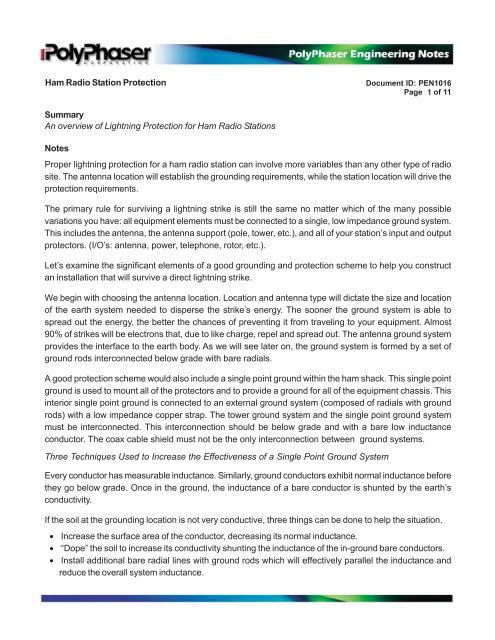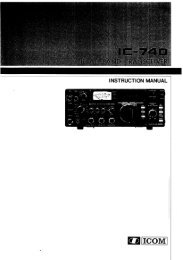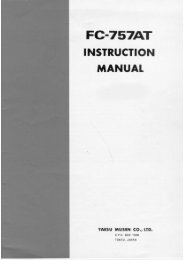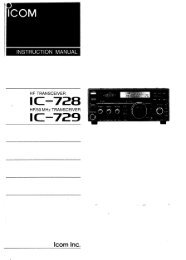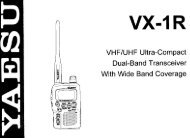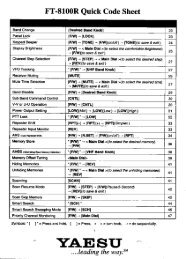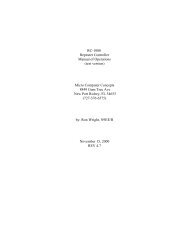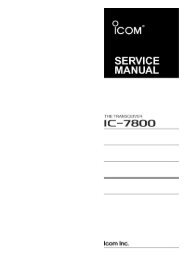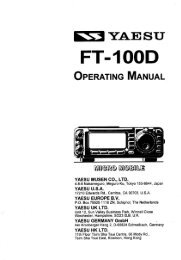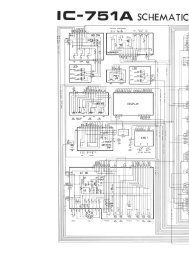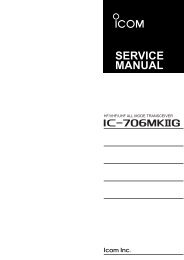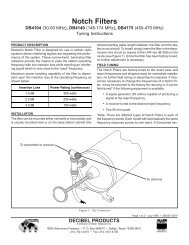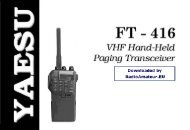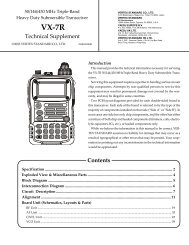Lightning Protection for Ham Radio Stations
Lightning Protection for Ham Radio Stations
Lightning Protection for Ham Radio Stations
Create successful ePaper yourself
Turn your PDF publications into a flip-book with our unique Google optimized e-Paper software.
L 7 load-break switchesMounting and dimensionsRefer Catalogue L 7LA 7 - base mounted switches - 3 poleTypeD3EFGHLTypeY min.X ≥Y max.L ≥LA 7-25/324.57015456459LA 7-25/3251429.590LA 7-40/634.58020547273LA 7-40/632.51509.590LA 7-80/1005.69525729089LA 7-80/1002.51509.590LE 7 - panel mounted switches - 3 poleTypeB1B2FHLLE 7-25/32-36456460LE 7-40/634836547274LE 7-80/1004836729090Control handlesCat. No. QPBLFS 2-A-448 x 482836LFS 2-E-448 x 482848LFS 2-A-664 x 642848LFS 2-E-664 x 642848LFS 2-N-667 x 673448LFS 2-G-667 x 673448Central hole fixing ø 22 mm (excluding L7-80/100)
<strong>Ham</strong> <strong>Radio</strong> Station <strong>Protection</strong>Document ID: PEN1016Page 37of 11occur. Most basements have concrete floors. Since concrete is a conductor, your equipment must not sitdirectly on the concrete. Doing so will allow surge energy to enter the shack and find a ground path throughyour equipment to the floor. Insulate your equipment with material that does not absorb water. Wood is nota good choice. Polypropylene is better than nylon to use as a full footprint sheet insulator. Obviously, youshould not be on the concrete floor touching the equipment when a storm is near!The first floor is the next best location. The magnetic shielding is less than the basement and the inductanceto ground is higher than the basement. If your tower is close to the building, the recommended groundingstrap, running down the outside wall, may inductively couple some energy from the tower. This is also true <strong>for</strong>other lines such as coax, tower lights and rotor lines. The longer this parallel run, the more energy will becoupled. Our recommendation is to protect these lines at the tower base then run them in EMT (electricalmetal tubing) steel conduit. The conduit should be grounded to the tower base ground point. This will act asa faraday shield <strong>for</strong> the cables inside. Do not run unprotected lines in the EMT. The protectors must begrounded to each other as well as to the tower ground. The best way to do this is to place the protectors insidea weatherized NEMA type box. Make sure the box is grounded, as well as the inside mounting plate. To dothis correctly, remove the paint from the box’s outside and inside surfaces at the ground point and use properjoint compounds to weatherize the connections. Stainless hardware may be used. Crimp lugs must be crimped,soldered and weather covered. Solder (60/40) will not hold up to sunlight and ozone without protection. Usea short section of strap to bond between the inside surface of the box and the inside protector mounting plate.High Rise BuildingsOur definition of a high rise building is different than the upper stories of a house. The antennas on a high riseare not on a ground mounted tower, but are usually attached to the building structure. There<strong>for</strong>e, a single pointgrounding plan is a must <strong>for</strong> a high rise equipment room. Grounding both the antenna and the single pointground connection in the equipment room is easy <strong>for</strong> buildings with structural steel frames - just bond to thebuilding steel. Buildings other than steel construction are not as simple. Some high rise buildings have a fireriser with a straight run to the basement where a super charger pump is usually connected. The riser may beused as a ground path if the pump’s power is protected and a strap jumper installed to take the strike energypast the pump’s gasket on both its input and output ports. If the riser is over 50 feet away, it may not be thebest ground path to use. Check <strong>for</strong> other paths such as existing building lightning rods with down conductorsor large electrical conduits. Do not use drain pipes or vent stacks. If none are available, regardless of the pathdistance, and it is impossible to run a strap down the side of the building, then the antenna just can’t begrounded! When an ungrounded antenna is hit by lightning, the energy will traverse the coax line to your singlepoint equipment ground location. This may be many meters from earth and the inductance/ resistance voltagedrop will be very large (hundreds of thousands of volts).The ideal plan is a single point ground with no sneak paths. Sneak paths are loops that allow lightning currentto flow into the equipment room. The easiest sneak paths to miss are the safety ground and the concrete floor(discussed above). The safety ground can be fixed by adding a distribution panel and protector at the single
<strong>Ham</strong> <strong>Radio</strong> Station <strong>Protection</strong>Document ID: PEN1016Page 38of 11point ground location or, <strong>for</strong> small sites, a plug-in protector grounded on the single point ground panel. All l/O’s (input/output) must be protected at this single point. The next thing to measure is distance. During a strike,distance equates to voltage drop to earth, the entire room of equipment will be elevated. The sharp cornersof equipment cabinets can breakdown the air, causing current to flow. This will be a very low current unlessanother path is found by these streamers. Heater vents and electrical conduits that are not grounded to thesingle point can become such paths. It is a good idea to bond (ground) all conductive objects within 1 meterof any single point earthed equipment in the room.Tower mounted equipment is similar to the above high rise situation. The l/O’s must be protected and theprotectors must be located and bonded together. Single point grounding should be easy to do if the equipmentis mounted inside a metal enclosure.Antenna SupportGround mounted vertical antennas require the same type earthing <strong>for</strong> lightning protection. A vertical antenna’simpedance is half of a dipole’s. Don’t stop short of a good ground plane. The better the ground plane <strong>for</strong> RF,the better the earthing <strong>for</strong> lightning. This is assuming that the RF ground plane is in the ground.If you have a antenna tuner fed long wire and the pole is just supporting the antenna wire, it would be a goodidea to have the grounded straps extend higher to intercept a strike or to divert energy to ground if the wireis struck. This can be done by either placing a high voltage gas tube between the long wire and the straps orby making an arc gap between the wire and the ground straps. A gas tube will not be adversely affected bytemperature, humidity, pollution, or wind, while the air gap will be affected. It may be difficult to calculate thevoltages present at the gas tube and it will change when switching bands. A rule of thumb is <strong>for</strong> about 7kV. Anair gap would be about 0.175" at sea level with 50% humidity and grows larger with elevation/humidity. (Humidair is less dense)Another gas tube or gap may be added closer to the antenna tuner. For dipole antennas with baluns, use thesame gas tube technique. Place gas tubes around the balun. Place one across the balun at the dipole wiresand one from each side of the balun to the ground straps. This will protect the balun from a strike to the dipolewires. The more strike energy you can divert to the ground be<strong>for</strong>e it reaches your equipment, the better offyou and your equipment will be.Just a word to those who tell us that they are safe from lightning because they always disconnect the coaxfrom their equipment. When asked what they do with the disconnected line(s), they usually respond that it isplaced on the floor. Now if you stop and think about the last few thousand feet that the lightning has jumped,you can see the fallacy of their thinking. In fact, they made it worse since arcing involves ignition temperatureplasmas inside your house. True, the radio may still work, if it survives the house fire. Throwing the coax outthe window is not a solution, especially if the coax has already entered the house from the antenna or theantenna is roof mounted without a ground path. Grounding switches will not last long with direct hits unlessother good ground paths are provided. Grounding the antenna line and not disconnecting the coax shield can
<strong>Ham</strong> <strong>Radio</strong> Station <strong>Protection</strong>Document ID: PEN1016Page 39of 11still allow strike energy to be shared with the equipment The shield connects to the chassis and if a single pointground is not present with power/telephone protectors, the equipment will be damaged.Power/Telco EntranceFull protection <strong>for</strong> a ham shack must cover not only strikes to your tower, but also hits from down the road toutility lines. By using single point grounding, your ham equipment will survive the hit to your tower. If theoutside (tower/perimeter) ground has a low impedance at lightning frequencies, most of the strike energy willbe dispersed into the ground and little energy will enter the shack. This is fine, but what if your ground hasdeteriorated over time or was never very good because of yard size?The ground system can absorb only so much energy be<strong>for</strong>e it becomes saturated. In 90% of the strikes, atraffic jam of electrons will be coming down your tower. If they cannot spread out in a reasonable time frame,the back up pressure (voltage) will find or create another path. The ground system, if too small in area, willcause more energy to traverse the cables and other lines to the shack. The I/0 protectors can keep thevoltage levels between the single point ground and the signal line(s) at survivable limits, but the energy is onlydiverted elsewhere. This could be the house phone lines and power lines.Other house appliances may be at risk. When the ground system is saturated, the energy is actually comingfrom the (utility) ground system and can go through your TV, <strong>for</strong> example, in an ef<strong>for</strong>t to leave the area by wayof the cable TV drop. Satellite dishes will also have the same problem. The best way to protect the rest of thehouse is to provide protection at a single point. The easiest single point will be at the power and telephoneentrance. The utility ground rod (which should have been already interconnected to your ground system) isused by both the power neutral and the telephone protector installed by the phone company. By placing apower mains protector and a secondary phone line protector at this location, the entire house will be protected.The cable TV or outside antenna coax should be rerouted and a good coaxial protector installed at this point.The cable company installed protector is usually just a grounding block earthing only the outside shield anddoes nothing to the center conductor energy that can have as much energy as the outside shield! As theground system rises in potential from a strike, the protectors will take the ground system energy and place iton the power, telephone, and cable TV lines while keeping the voltages between earth and the active lineswithin the limits of equipment survival.The utility ground rod <strong>for</strong> the house should have already been interconnected to your ground system. Whatif this can’t be done? If this is not done, the energy from the tower strike will traverse the house safety groundwires to this rod, causing problems. The reason to interconnect them in the ground using bare conductorswas to reduce the inductance of the interconnecting path. It is true that the house wires are a parallel path andthere is nothing we can do about it. If the interconnect path is better (lower inductance and resistance) themajority of the current will bypass the house wiring. The only alternative is to provide a copper strap paththrough the house. This may not be a sufficiently low inductance path and it will radiate to other wires/equipment inside the house.
<strong>Ham</strong> <strong>Radio</strong> Station <strong>Protection</strong>Document ID: PEN1016Page 10 3 of 11The power and telephone feeds to your house can be either aerial or underground. Most people thinkunderground is better from a lightning standpoint. Buried underground, it will not be hit directly, but if a nearbytree is hit, the amount of energy coupled through the conductive ground medium can be almost equal to adirect hit. By being underground, the shielding effect to the wires is not great. The buried depth does littlewhen compared to the depth low frequency strike energy penetrates. When you consider the cost ofunderground utilities, these and the aesthetics must be weighed.Ground System MaterialsSolid copper wire/strap and copper clad steel rods, makes copper the most commonly used earthing material.Your below grade ground system should be made with the same material throughout. Mixing of materials, likegalvanized rods with bare copper radials, will create a battery action and the zinc of the galvanized rods willbecome sacrificial, dissolving into the soil. This leaves bare steel to rust and not provide an optimum connectionto earth. (Note: when wet, rust can conduct, but not very well.) Using stainless rods in order to preventcorrosion will not provide the best conductivity. Since stainless wire will be required to interconnect the rods,the resistance of the system will increase. An all aluminum ground system should only be considered in veryacid soil conditions and even then it should be chemically tested <strong>for</strong> other attacking soil compounds.Joints between copper radials and copper clad rods should be made by exothermic welds or by using jointcompounds in high compression clamps. Solder connections, even torched silver solder connections will notlast as long as the above. An exothermic weld is created when a graphite mold around the connection is filledwith copper oxide and aluminum powders. An additional starter powder ignites the exothermic process. Theresultant molten copper is deposited into the lower mold cavity where it burns away any oxides and createsa larger fused connection. The larger cross sectional bond decreases the resistance and increases thesurface area, reducing the inductance of the joint. Since the materials are all the same, the connection will lastas long as the rest of the grounding material. High pressure clamps provide a meshing of copper to coppersince the material is soft (malleable). The use of joint compounds further enhances the weather tightness ofthe bond. The high pressure will need to come from another material stronger than copper.If you find a rock layer is making the ground rod insertion difficult and you can’t remove the rod to start overa few feet away, the best idea is to cut off the rod and connect it to the system. A rock layer will hold water andsalts so the conductivity above should be good. Making more connections to areas of higher conductivity willreduce the overall impedance of the ground system (resistance and inductive reactance).The ground system has a resistance and an inductance value. (It has capacitance too!) The amount andlocation of the inductance can choke off the effectiveness of radials. When a radial is in poorly conductivesoil such as buried in a dry, sandy layer, the radial inductance can be calculated as being in air (a very poorconductor). When the radial runs in highly conductive moist soil (or doped soil), the inductance of the wire isshunted by the soil’s conductivity, making it unimportant.
<strong>Ham</strong> <strong>Radio</strong> Station <strong>Protection</strong>Document ID: PEN1016Page 11 3 of 11Since copper strap has lower inductance than wire, it is recommended <strong>for</strong> the radial run. The strap’s extrasurface area reduces the inductance and the sharp edges allow <strong>for</strong> a high E field concentration <strong>for</strong>cing morecharge into the soil. Short multi-point (like barbed wire) type grounding systems have been tried and have notbeen as effective as the sharp edge of copper strap <strong>for</strong> ground rod interconnecting material or <strong>for</strong> radial runswithout rods. Copper strap radials have been proven successful on bare mountain top solar powered siteswhere ground rods could not be used. The strap edges helped disperse the strike’s deposited charge to thetower by arcing onto the mountain surface, saving the solar powered radio equipment at the site.Adding ground doping material to your radial trenches and rods can be helpful. Stay away from gels and otherchemicals that can shorten conductor life. All add-on conductive earthing materials do little except make yourcopper conductors larger (more conductive surface area). This gives some percentage of improvement butit still must interconnect to conductive soil where it has both salts and moisture. If the soil is dry around theearthing material, the connection to earth will be poor, regardless of the advertised claims. If the area is notlarge enough, the earth connection will suffer. By increasing the area of your ground system with the additionof more radials, the same improvements can be obtained <strong>for</strong> less money.LongevityAfter doing all this work, Mother Nature still has a way of making anything we do temporary. Once a groundsystem is in the ground it will start to age. Copper and other metals are attacked by acids, while aluminum isattacked by bases. Other chemicals may be present in the soil causing decreased effectiveness of thegrounding materials. This is why maintenance testing is important. While some ground systems last 30 years,others don’t even last two years! There are two ways of finding out if your ground system is in need of work.One is after a lightning strike and is too late! The other is to measure the system. An old timer once told methat he tested a ground by disconnecting it from everything and connecting it to power “hot” through a 30 ampfuse. If the ground was good, the fuse would blow. This is not the way to test a ground and it could change thesoil conductivity by attempting such a test. The proper way is to use an earth resistance meter providing a fallof potential type test. Be careful when connecting a ground system to your electrical utility ground rod.Depending on ground conductivity, harmonic and other currents, there could be current flow causing a sparkwhen connected.Last Reviewed: 1/9/03


